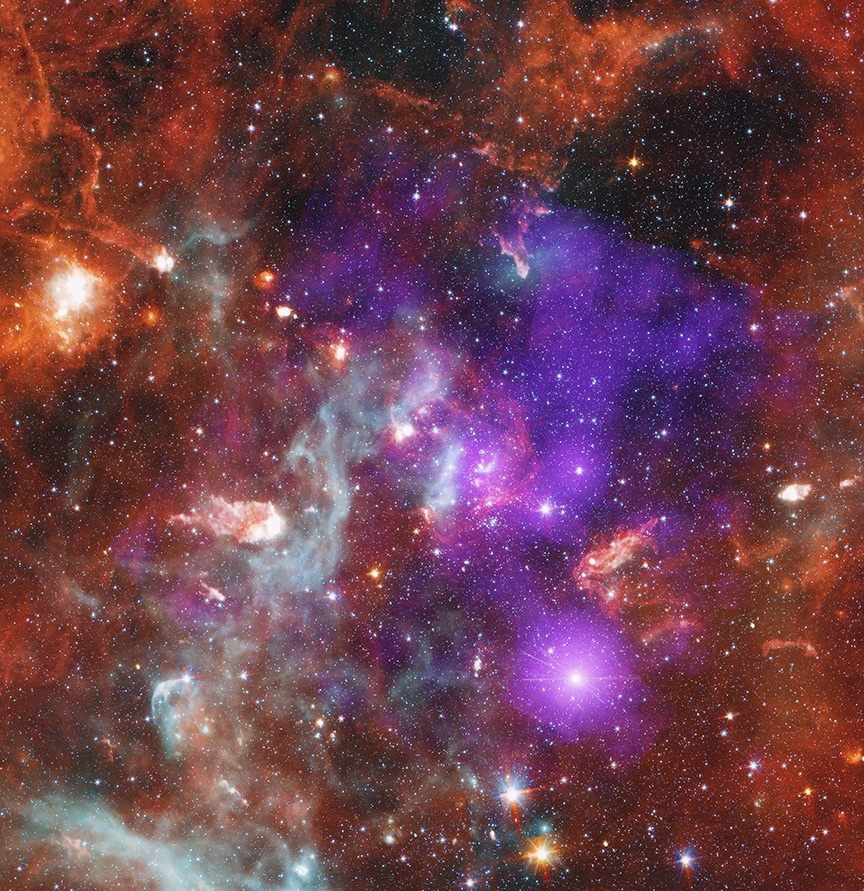Using ultraviolet, optical, and infrared data from NASA’s Chandra X-ray Observatory, a group of astronomers demonstrated the locations of some of the most dangerous regions in a star cluster, where the likelihood of planet formation is reduced.
 Cyg OB2. Image Credit: X-ray: NASA/CXC/SAO/J. Drake et al, IR: NASA/JPL-Caltech/Spitzer; Image Processing: NASA/CXC/SAO/N. Wolk
Cyg OB2. Image Credit: X-ray: NASA/CXC/SAO/J. Drake et al, IR: NASA/JPL-Caltech/Spitzer; Image Processing: NASA/CXC/SAO/N. Wolk
Stars often form in groups called clusters or associations, frequently containing massive stars. These giants emit powerful high-energy radiation that can disrupt the delicate disks of gas and dust necessary for planet formation.
To explore the most hazardous areas for planetary development, a team of astronomers utilized NASA’s Chandra X-ray Observatory, along with ultraviolet, optical, and infrared data, to pinpoint where planets are less likely to form within a star cluster.
The team focused on Cygnus OB2, the closest large star cluster to our Sun, located about 4,600 light-years away. Cygnus OB2 is home to hundreds of massive stars and thousands of smaller stars. By gathering long Chandra observations across various regions of Cygnus OB2 and stitching them into a composite image, the team created a panoramic view of this dynamic environment.
The detailed Chandra images revealed diffuse X-ray emissions between stars and cataloged young stars within the cluster. Combining this with optical and infrared data, astronomers assembled the most comprehensive census of young stars to date.
In the composite image, Chandra data (shown in purple) displays the X-ray emissions and young stars in Cygnus OB2, while infrared data from the now-retired Spitzer Space Telescope (red, green, blue, and cyan) highlights cooler dust, gas, and young stars throughout the area.
In such densely packed regions, abundant high-energy radiation from stars poses a threat to nearby forming planetary systems. Together, X-rays and intense ultraviolet light can erode the disks where planets are forming.
These planet-forming disks typically dissipate over time, with some material falling onto the star while the rest evaporates through a process called “photoevaporation.” This usually takes 5 to 10 million years for average-sized stars, but the presence of massive, high-radiation stars nearby accelerates the effect.
The team’s research found clear evidence that planet-forming disks vanish faster when they are close to massive stars emitting intense radiation. They also found that disks disappear more quickly in densely populated areas within the cluster.
In regions of Cygnus OB2 with lower radiation and fewer stars, around 40 % of young stars retain their disks. However, in high-radiation areas with a greater number of stars, only about 18 % of young stars still have disks. The most hazardous areas for developing planetary systems lie within 1.6 light-years of the cluster’s largest stars.
A separate study by the team analyzed the diffuse X-ray emissions in Cygnus OB2, revealing that high-energy emissions arise where gas winds from massive stars collide, heating the gas enough to produce X-rays. Less energetic emissions likely result from gas within the cluster colliding with the surrounding gas.
These findings are detailed in two recent studies using Chandra data on Cygnus OB2. Mario Giuseppe Guarcello (National Institute for Astrophysics, Italy) led the research on planetary hazard zones, published in the Astrophysical Journal Supplement Series in November 2023, while Juan Facundo Albacete-Colombo (University of Rio Negro, Argentina) headed the study on diffuse emissions, appearing in the same journal.
NASA’s Marshall Space Flight Center manages the Chandra program from Huntsville, Alabama, with scientific operations overseen by the Smithsonian Astrophysical Observatory’s Chandra X-ray Center in Massachusetts. The Spitzer Space Telescope mission was managed by JPL until its conclusion in January 2020, with its data archived at Caltech's Infrared Science Archive.
Journal References:
Guarcello, M. G. et. al. (2023) Photoevaporation and Close Encounters: How the Environment around Cygnus OB2 Affects the Evolution of Protoplanetary Disks. The Astrophysical Journal. doi.org/10.3847/1538-4365/acdd67
Albacete-Colombo, J. F. et. al. (2023) Diffuse X-Ray Emission in the Cygnus OB2 Association. The Astrophysical Journal. doi.org/10.3847/1538-4365/acdd65